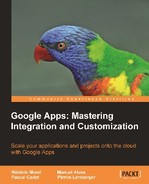The Google Apps Platform includes a large array of applications and services that are tightly integrated with one another and that can be put into three categories.
The communication tools category comprises Gmail, an email system that is currently the state of the art in its category. In the same category, Google Calendar is an online agenda with advanced sharing and publication features. Finally, Google Talk is an instant messaging system combined with audio and video communication. The Google Groups tool allows, among other things, managing mailing lists and can also be put in this first category. Chapter 3, Communication Tools will be dedicated to these tools and will also touch on the availability of these tools on mobile terminals.
The collaboration tools make up the second category of services. Google Sites and Google Docs are the most important among them. Google Sites is a tool for quickly creating simple websites and publishing them. In some aspects, Google Sites is closer to a wiki than a traditional web content management system. Google Docs is an online office suite that includes, as you would expect, a word processor (Google Documents), a spreadsheet (Google Spreadsheet), and a presentation tool (Google Presentation). Google Video also belongs to this category of sharing tools. These topics will be addressed in Chapter 4, Collaboration Tools.
All these use the same address book, and this contributes largely to the integration of the various tools. This very high level of integration is what distinguishes the Google Apps from competing offers. For this reason, we will emphasize using these tools jointly when one application benefits from the services of another. For example, you can easily include a Google document or an agenda in a website created with Google Sites.
Finally, the last category of tools comprises the security tools. These are the Postini services. Postini is a specialized company that designed these services, and was subsequently acquired by Google. Here, we'll distinguish protection tools such as antivirus and anti-spam tools from the archiving and search tools. These tools are intended for domain administrators. Chapter 5, Security Tools introduces the primary features that are available in the Postini administration console which, as we shall see, is rather complex!
Each deployment of the Google Apps is associated with a domain name (my_googleapps.com). A console linked to this domain name groups all administrative tasks related to a deployment. These are described succinctly at the end of Chapter 3, Communication Tools and Chapter 4, Collaboration Tools for the application themselves and in Chapter 5, Security Tools for the security services.
The following figure schematically represents the interconnection between the Google Apps and the IS. It also shows the tasks implied by a migration to the Google Apps starting from a classical architecture. The migration issues will be the subject of Part 3.

Transition between a classical email system and a Google Apps deployment.
Google Apps services are available in three editions:
The features of the various editions are summarized in the following table:
|
Google Apps (free) |
Google Apps for Education |
Google Apps for Business Edition | |
|---|---|---|---|
|
Price |
Free |
Free for accredited institutions |
$50 per user per year |
|
Communication tools: Gmail et Google Calendar |
YES |
YES |
YES |
|
Collaboration tools: Google Docs et Google Sites |
YES |
YES |
YES |
|
Other enterprise applications: Google Video and Google Groups |
NO |
YES |
YES |
|
Maximal number of users |
50 |
No limit |
No limit |
|
Maximal number of emails sent |
500 emails per day per account |
2000 emails per day per account |
2000 emails per day per account |
|
Storage space |
7.6 GB |
25 GB for mail |
7.6 GB |
|
Availability |
No SLA |
99.9 % SLA |
99.9 % SLA |
|
SSL security, SSO and strengthened security requirements |
NO |
YES |
YES |
|
Advertisements |
YES |
None |
None |
|
Support |
NO |
24/7 phone support |
24/7 phone support |
|
Online help |
YES |
YES |
YES |
Thus, Google Apps is a suite of collaborative tools aimed at both large and small companies. Beyond the online tools that come with the Google Apps, Google offers Google Apps Engine, a platform for deploying and hosting web applications and Google Apps Marketplace, a platform for purchasing services. These two topics will be addressed in Chapter 6, Extending the Platform.
|
Name of the Application |
Description of the Application |
|---|---|
|
Communication Tools | |
|
Gmail |
Email by Google. It includes search tools and offers offline access. It also integrates instant messaging and video. |
|
Google Calendar |
Calendar and planning tools. |
|
Google Talk |
Instant messaging. It also exists as a standalone application and integrates with Gmail. |
|
Collaboration Tools | |
|
Google Docs |
An online office suite, which includes a word processor, a spreadsheet, and a presentation tool. |
|
Google Sites |
A collaborative web content management tool that borrows from the wiki philosophy. |
|
Google Video |
A video sharing tool. |
|
Security Tools | |
|
Postini Services |
A set of security (anti-spam, anti-virus, various filters) and mail archiving services |
|
Extensions of the Platform | |
|
Google Apps Market Place |
A website for purchasing applications to enhance the Google Apps platform. |
|
Google Apps Engine |
A solution for designing and hosting web applications on Google's high-availability infrastructure. |
